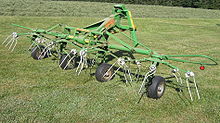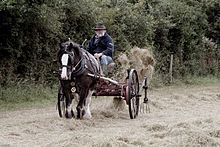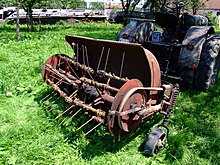Hay tedder
A Tedder (also tedder, Kreiselwender, Tedders, north German sweeper or Switzerland Heuzettler) is an agricultural implement that in the drying process of grass for hay - or silage is used. It is one of the feed advertising devices.
task
Tedders have the task of promoting the drying of cuttings. This is why they distribute the freshly cut crop evenly on the sward in order to accelerate drying (tedding). The wilted material is then often turned over until the desired degree of dryness has been reached, depending on the type of preservation. Depending on the technology used and the crop , advertising losses of up to 30% can be expected. Hay tedders must be tailored to the respective mowing technology in order to avoid driving over the mowing swaths and to achieve an optimal tedder result.
development
The hay tedders and rake machines were developed as early as the 19th century. Almost all major agricultural machinery manufacturers had forked hay tedders in their range before the First World War, and they did so with considerable sales figures. One example is the Fahr company , which was able to sell over 55,000 fork tedders between 1896 and 1936; In the entire production period between 1896 and 1963 101,933 pieces, which at the beginning were only set up for animal traction.
After the Second World War , the machines and devices became state-of-the-art. H. adapted to the tractor operation. In 1959 the Allgäu farmer Josef Maugg brought a haymaking machine on the market that had a spinning top (prototype in the Swabian Farm Museum ). At Fahr they recognized the potential of this machine and improved this single circuit. Since the working width - in contrast to the other inventions - can be increased practically unlimited with more rotors, his triumphant advance could not be stopped.
equipment
Rotary tedders

A rotary tedder consists of one or more pairs of tine rotors, which are fastened under a frame that is usually foldable. There are four to eight tine carriers on the rotors, with double tines made of spring steel at the end. The rotors, which are driven by the PTO shaft of the tractor , rotate in pairs against each other; therefore there are only devices with an even number of tops. Each rotor rotates around a vertical axis inclined in the direction of travel, so that the tines which are located in front of them, as seen in the direction of travel, touch or almost touch the ground. A spindle mechanism can be used to place the rotors on the ground to a greater or lesser extent, as required by the nature of the crop to be tilled or turned for a good work result. So that the set work intensity of the rotors is maintained on uneven terrain, each rotator has a feeler wheel that follows the uneven ground. The still fresh grass or the wilted material is thrown backwards with a rotor speed of approx. 120 min −1 in order to distribute the mowing or to turn it over for the further drying process.
Some of the rotary tedders are equipped with an additional reduction gear, which reduces the speed of the rotors to such an extent that the crop is only balanced together but no longer thrown up. This means that night swaths can also be laid without having to change equipment. Usually, however, a rake is used to pull the night swaths .
There are also rotary tedders with devices for so-called border spreading so that the forage is not spread on neighboring properties. There are pulled tedders (attachment to the tractor 's drawbar) or for attachment to the three-point hydraulic system of the tractor. Modern devices with a larger working width can be folded up hydraulically for road transport . Rotary tedders are manufactured in working widths of approx. 1.8–20 m.
Fork tedder
The fork hay tedder is a design developed as early as the middle of the 19th century. The way it works is based on manual haying with a fork. The individual forks are attached to a crankshaft and throw the crop backwards in portions (picture). The advantage of the fork tedder is the gentle treatment of the nutrient-rich leaves in the almost dry hay. The disadvantage is that when the freshly cut and still heavy grass is turned for the first time, larger portions tend to be left un-turned. Fork turners were produced until the 1960s and replaced by PTO driven rotary tedders.
Vibrating tedder
The device, which is driven by a cardan shaft, loosens the green waste by moving the spring-loaded tines back and forth.
Rotary turners
Two horizontal rotors running in opposite directions, which are PTO-driven, are fitted with tines that are sloping downwards. These pick up the green waste and throw it backwards. Due rear mounted collecting baskets one is windrowing as a swather possible. Their distribution is low because of the limited work performance.
Drum turner
Here three tine combs are mounted across the direction of travel. They turn in a circle, similar to the reel of a combine harvester and throw away the stalks at the bottom to the rear. A special design, the drum-tedder that in one operation with the mowing means of a Fingermähwerkes zettet the previous swath (distributed). It works against the direction of travel and throws out the swath at the top. A push rake turner , also a drum turner , can also work against the direction of travel . Since the axis of rotation can be set diagonally to the direction of travel, swathing is also possible. It is one of the multiple devices.
Belt or chain turners

Belt rake or belt rake or belt rake are a frequently used device in mountain agriculture. As self-propelled hand-held power tools, they can be used on slopes up to 80%. Controlled tines are mounted on plastic, rubber belts or gear chains that run across the direction of travel. The cuttings are ejected to the side by the tines that graze vertically on the ground. Swathing is possible by attaching a grass catcher. The restricted working width is meaningless in the areas of application.
The advantage of the belt hay is its low weight and the construction of the device close to the vehicle. This allows a much better slope suitability than it is with a z. B. Rotary rake is the case. In order to achieve a higher driving speed, there are now conveyor belts for slope implement carriers with up to 5 rows of tines.
However, there are also wider versions (center rakes) that can reach working widths of up to 5 meters.
literature
- Wolfgang Baader: The big driving book , DLG-Verlag, Frankfurt am Main 2005, ISBN 3-7690-0647-X .
- Udo Bols: Agricultural implements for tractors in earlier times . Verlag Podszun-Motorbücher GmbH, Brilon, ISBN 978-3-86133-441-5 .
- Agriculture: Volume 3 - Agricultural engineering and construction . BLV Verlagsgesellschaft, Munich, ISBN 3-405-14349-7 .
- Rudolf Hamm, The whole of agriculture, Arnoldsche Buchhandlung, Leipzig 1872 (reprinted by Th.Schäfer Verlag, Hanover, ISBN 3-86047-139-2 )
Web links
Individual evidence
- ↑ How does it work? Technology in today's life, 2nd edition, Bibliographisches Institut / Meyers Lexikonverlag, Mannheim / Vienna / Zurich, 1978, ISBN 3-411-01732-5 , p. 576 f.
- ↑ Michael Koch, Traditional work with horses, Verlag Eugen Ulmer, Stuttgart, 1998, page 65 f.
- ^ Wolfgang Baader, Das große Fahr-Buch, DLG-Verlag, Frankfurt am Main, 2005, p. 93.





